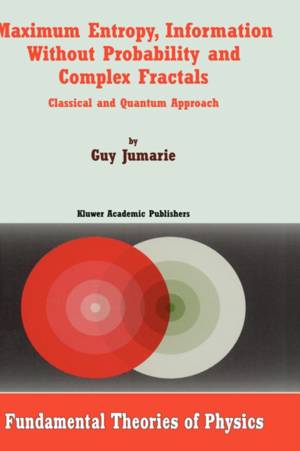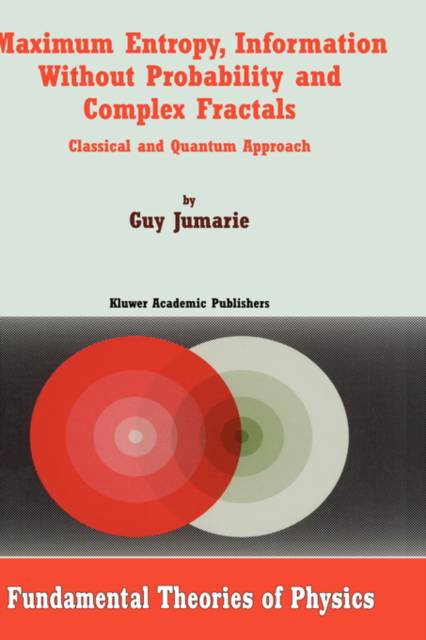
- Afhalen na 1 uur in een winkel met voorraad
- Gratis thuislevering in België vanaf € 30
- Ruim aanbod met 7 miljoen producten
- Afhalen na 1 uur in een winkel met voorraad
- Gratis thuislevering in België vanaf € 30
- Ruim aanbod met 7 miljoen producten
Zoeken
Maximum Entropy, Information Without Probability and Complex Fractals
Classical and Quantum Approach
Guy Jumarie
€ 167,95
+ 335 punten
Uitvoering
Omschrijving
Every thought is a throw of dice. Stephane Mallarme This book is the last one of a trilogy which reports a part of our research work over nearly thirty years (we discard our non-conventional results in automatic control theory and applications on the one hand, and fuzzy sets on the other), and its main key words are Information Theory, Entropy, Maximum Entropy Principle, Linguistics, Thermodynamics, Quantum Mechanics, Fractals, Fractional Brownian Motion, Stochastic Differential Equations of Order n, Stochastic Optimal Control, Computer Vision. Our obsession has been always the same: Shannon's information theory should play a basic role in the foundations of sciences, but subject to the condition that it be suitably generalized to allow us to deal with problems which are not necessarily related to communication engineering. With this objective in mind, two questions are of utmost importance: (i) How can we introduce meaning or significance of information in Shannon's information theory? (ii) How can we define and/or measure the amount of information involved in a form or a pattern without using a probabilistic scheme? It is obligatory to find suitable answers to these problems if we want to apply Shannon's theory to science with some chance of success. For instance, its use in biology has been very disappointing, for the very reason that the meaning of information is there of basic importance, and is not involved in this approach.
Specificaties
Betrokkenen
- Auteur(s):
- Uitgeverij:
Inhoud
- Aantal bladzijden:
- 270
- Taal:
- Engels
- Reeks:
- Reeksnummer:
- nr. 112
Eigenschappen
- Productcode (EAN):
- 9780792363309
- Verschijningsdatum:
- 31/05/2000
- Uitvoering:
- Hardcover
- Formaat:
- Genaaid
- Afmetingen:
- 156 mm x 234 mm
- Gewicht:
- 589 g

Alleen bij Standaard Boekhandel
+ 335 punten op je klantenkaart van Standaard Boekhandel
Beoordelingen
We publiceren alleen reviews die voldoen aan de voorwaarden voor reviews. Bekijk onze voorwaarden voor reviews.







